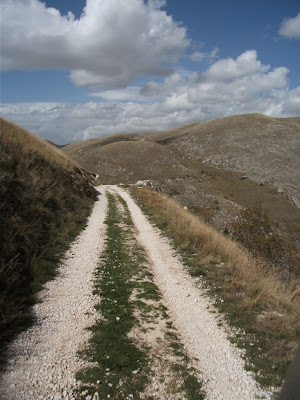Located just to the west of the Monte Genzana Alto Gizio Nature Reserve, this 6 km hike covering 370 meters (1,200 feet) of elevation gain connects two beautiful Italian hill towns (Anversi degli Abruzzi and Castrovalva) and returns via a spectacular gorge complete with towering walls, a river torrent, and plenty of flora and fauna. We can thank the book,
Walking in Abruzzo, for pointing out this hike to us.
To start, a little advance research helped us to find a better place to park than the book recommends. Before getting to Anversa proper, a left hand turn past what looks like a large water treatment building takes you down to a car park next to the entrance of the botanical garden where the hike begins.
The first and only climb of the hike took us up to a point with great views looking back on Anversi degli Abruzzi. On the way, we received the good wishes of a gardener who left us with a friendly warning to be careful of
cinghiali, wild boars that live in the area and are a delicacy on the dinner table here.
After the climb, the trail draws level in elevation with Castovalva. Here's our first glimpse of the picturesque town from across a steep ravine. M.C. Escher used as a model for one of his famous illustrations.
The route then heads into Castrovalva proper, which is perched high on a precipice overlooking the Sagittario River gorge and Anversi degli Abruzzi. A short detour takes you out to the Chiesa di San Michele, a church that sits on the furthest point outside of town and is surrounded by cliffs on three sides.
The descent route from Castrovalva into the gorge, or
gole, of the River Sagittario, utilizes stone steps, dirt trails, and the auto road. The entrance to the gorge is marked at an intersection of the road with another main road to Scanno.
Leaving the auto road, the trail into the gorge offers a full canopy of tree cover. We encountered interpretive signage and warnings to heed the rock falls as well as numbered stations along a "geological trail." Basically, the trail that we were following back
towards Anversa doubles as a geological route
out of Anversa... a little confusing, but we figured it out.
The Sagittario River - really not much more than a stream - races through the gorge at a fast clip, but in parts it also forms slow moving pools with beautiful green mosses and other aquatic plant life. Nearing Anversa, it is diverted into a channel for the town's water supply.
The route through the gorge was extremely peaceful. We encountered not a single person and enjoyed the sounds of birds and rushing water. Numerous bridge crossings and glimpses through the canopy of the towering cliffs on both sides added to the experience of a really special place.

























































